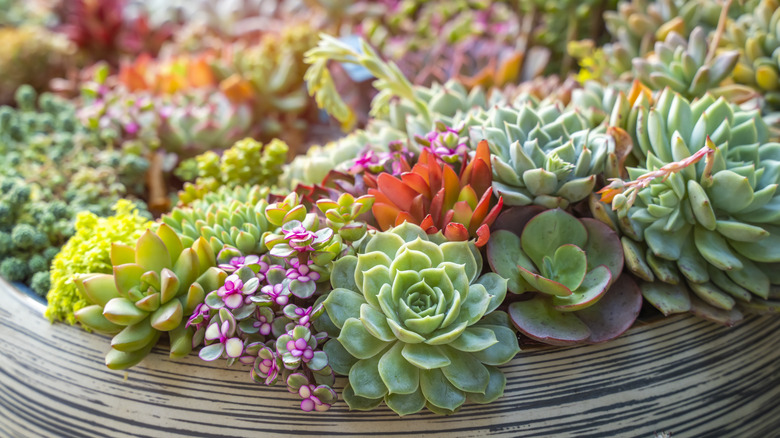When you first bought your Red Carpet sedum back from the nursery, it boasted tropical sunset-colored margins, tips, and foliage. Just a few weeks later, those vibrant colors have disappeared, replaced by an honestly quite boring grass green. The good news is that you can get that alluring crimson back in no time flat. All you need to do is subject your succulent to a little stress.
That may sound dramatic, but you won’t actually harm your succulent. Think of it more as manipulating its ability to survive harsh climates to achieve the look you prefer. Like all plants, succulents require just the right amounts of water and sunlight to thrive. They also function best within their natural temperature range. The problem is that thriving succulents tend to stay a uniform green. And we’re going for vibrant pinks, oranges, purples, and blues, right? You need to learn how to reduce or change these three factors to encourage some color.
But first, a little science lesson. There are two pigments responsible for the bright colors in succulents (and, perhaps unsurprisingly, in fruit, too): anthocyanins and carotenoids. These pigments appear when a succulent is stressed or in a state of dormancy — what’s known in biology as drought deciduous. They mask the more common, green-colored chlorophyll, turning the plant to other, arguably more appealing, shades.
Sunlight, water, and temperature
Plants produce pigments to protect them from UV radiation; a light green leaf is susceptible to scorching. Increasing the amount of sunlight your succulents receive is highly likely to restore their blush. Aim for at least four hours of direct sunlight exposure. If you’re growing colorful succulents that will thrive indoors (at least, that’s the goal), place them in a window that receives intense morning sun or use UV or blue grow lights instead. Too little sun (or time under grow lights), and your plants will stay green.
The amount of water your succulents are receiving matters, too. Succulents are able to survive in the harsh desert climates they’re adapted to because of their fleshy leaves and, sometimes, stems. These thick appendages are tiny biological water tanks, storing water for times of drought. Well-watered succulents aren’t stressed; they don’t need to draw on their stores of water. This keeps them green. Turn down the watering a little, say, to once every two weeks instead of once every week, and you may get some colors.
How much stress is too much?

Succulents are desert plants, and deserts are places of temperature extremes. Most succulents prefer temperatures between 40 and 90 degrees Fahrenheit. Since a color change in succulents happens when they’re stressed, you’ll see the best results at the lower and higher ends of this range. If your succulents live outdoors, you’ll be at the mercy of local weather patterns; indoor gardeners have more control over growing temperatures.
Whether fertilization, soil quality, and pot size make a difference in succulent coloration is unclear. Some experts claim that a lack of nutrients prompts bright colors — again, this is a stress response. Others claim adequate nutrition leads to pale plants. Succulents also don’t like wet feet, so you need to house them in planters with lots of drainage holes and sandy, pebbly, well-draining soil.
While it’s hard to really damage succulents in your quest for color, it’s not impossible. Make changes to your succulents’ environmental conditions and inputs gradually, keep detailed records, and watch out for signs of too much stress. After all, you don’t want to end up in a situation where you have to revive a dying succulent! Sunburnt or scorched leaves are pale, shriveled, and curling. Thirsty succulents look dry and wrinkled. Deep red dots or misshapen leaves indicate disease or a pest problem. A sickly yellow color could mean anything from overwatering and insect predation to too much shade or nutrient deficiencies.